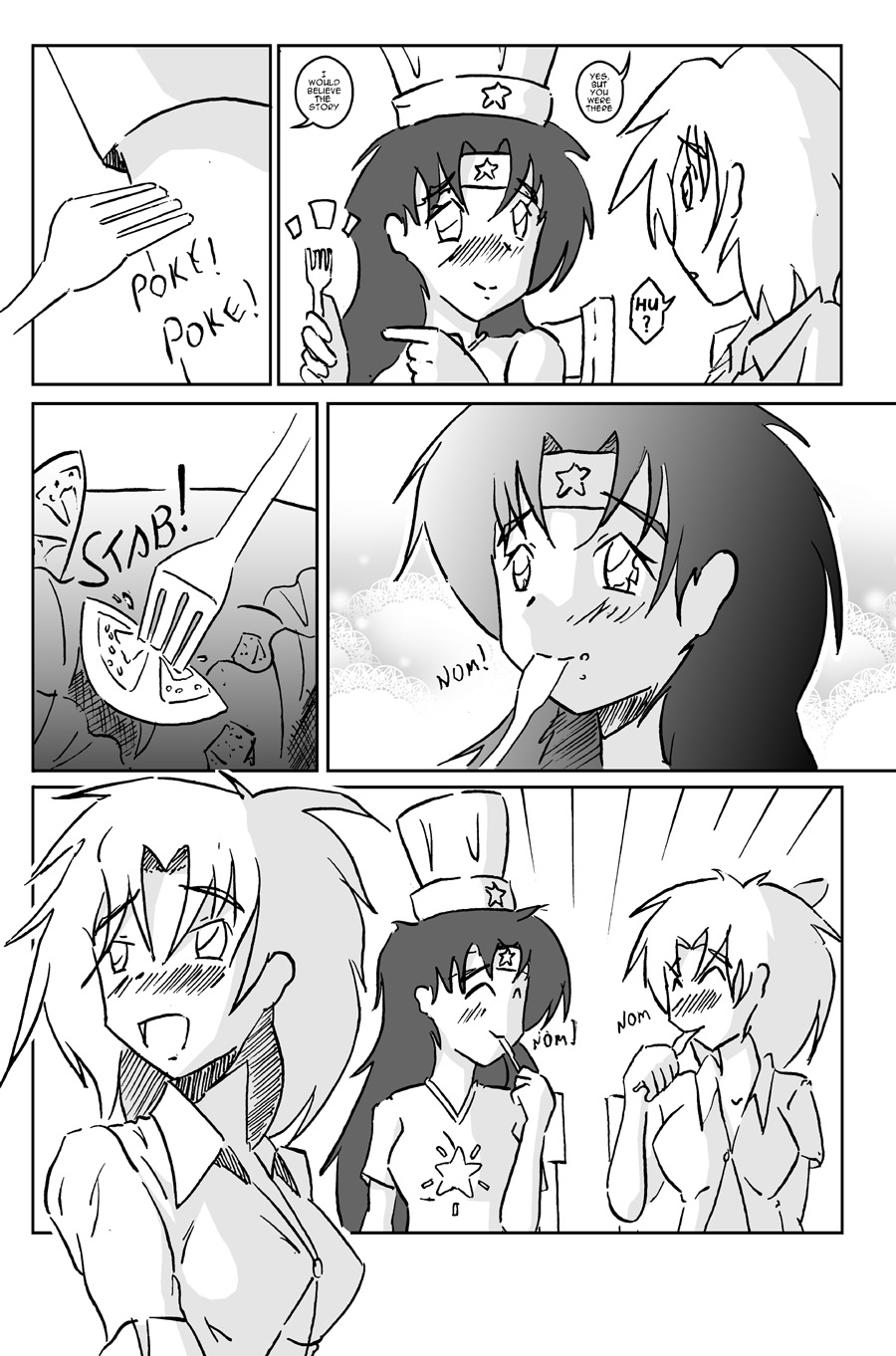While the other two continue to jabber on about the situation, Aoife moves onto more important matters….like showing Áine how to stuff her gob 😀
I originally was going to leave this page without dialogue, but I really wanted to add a little bit of Ashling & Fiona’s conversation, just to set the scene a little more.
This was the 5th page in a row, meaning that there’s no Bata Neart next Friday. Please drop by on Friday September 9th for the next page 🙂




Awwww, they’re bonding. How cute. ^_^
hmmm? Is that a UPS truck I hear pulling up? 😛
Random note: Aine’s never seen a tomato before.
Yanno, Fiona should really point out to Ashling that if they go to social services with Aine and they don’t believe their story, they’ll prolly think that they’re hiding something, and investigate. Maybe call the police. Ashling could wind up spending several hours in an interrogation room being asked over and over something to the effect of, “We know you kidnapped her from somewhere – things will go much better for you if you just tell us where.”
@Kessy: Glad you liked it 😀 (UPS? Huh?)
I guess you are right about the tomato. Although you can grow tomatoes in Ireland, they are not native to the island and probably did not appear by Áine’s time.
This was my thinking too when it came to writing dialogue for Fiona and Ashling’s conversation. There simply isn’t a Department for Time-Displaced Persons in Ireland or any other state (that I know of). No civil servant would likely believe their story, or worst case as you put it, get An Garda Siochana (The Police Service in Ireland aka ‘The Gardai’) involved. This will probably be one of the rare points in the series where the girls will actively try to hide the truth. Mostly to save themselves hassle than to protect Áine from non-existent government interest 🙂
UPS is United Parcel Service, one of the largest delivery companies in the world. https://en.wikipedia.org/wiki/United_Parcel_Service
…(waits for it to click)…
Tomatoes are native to the Americas and weren’t introduced to Europe until the Columbian Exchange. It may seem odd to think of today, but the same is true of potatoes – Aine’s never seen one of them either. Nor corn (maize), tobacco, vanilla, chocolate, turkey, sweet potatoes, chili pepper, paprika, pineapple, cashews, peanuts, blueberries, cranberries, or pecans, among other things.
Actually, at first many Europeans refused to eat tomatoes because they are a member of the nightshade family, which includes some extremely deadly poisonous plants including belladonna.
I love how clever Aoife is at helping Aine navigate all this new stuff. 🙂 I am waiting, however, for when Aine encounters the humble pea. I’m pretty sure she has learned a different technique to deal with such things. ^^
@Kessy: Potatoes are also members of the nightshade family, as are peppers, eggplant, and…..tobacco. 🙂
@Delta: indeed, and the only one of those that existed in the Old World prior to Columbus is the eggplant, which was also believed to be toxic by Europeans for a time. And the fruit of the potato plant is actually poisonous. And tobacco seems to be much more typical of the family. 😉
Oh, and something else it occurred to me is from the Americas that Aine has never seen is a guinea pig. If any of the girls have one as a pet Aine would prolly be intrigued by it.
Although thinking about all the things from the Americas we take for granted to make food tasty does put some perspective on why the spice trade was such a big deal.
@Rawr: I have a completely random and unrelated question, if you don’t mind. I was wondering what the exact significance of the phrase, “the wearing of the green.” Growing up I was taught that wearing a green piece of clothing, particularly on St Patrick’s day, is a sign of Irish heritage and pride. I realize that green is Ireland’s national color, but I was listening to the song “The Wearing of the Green,” https://www.youtube.com/watch?v=RZku2REI-Xs and I was thinking that even at the worst of times surely the English didn’t hang people simply for wearing something green. So I was wondering if it meant something more specific – some particular kind of clothing? Or maybe if it was just a metaphor for Irish patriotism?
@Kessy: I have a friend who can’t eat eggplant because she’s sensitive to it and it makes her tongue and lips swell.
@Kessy: I believe that song references the Rebellion of 1798. Back in the years when the US and France were getting all ‘revolution-y’ Ireland wanted to join in on all of the fun and began a revolt against British rule. It was an ambitious attempt at Irish Independence that may have succeeded if French re-enforcements had managed to land (storms prevented this).
The rebellion was organised by Wolfe Tone’s ‘United Irishmen’, who used a green version of the Kingdom of Ireland’s Blue-Harp flag. Displaying the Green version of this flag indicated that you belonged to the militia of the United Irishmen.
The rebellion started off well for the rebels, but without the French re-enforcements they were hopelessly outnumbered by the British forces that retaliated. The United Irish forces and their civilian supporters were slaughtered by a British Army that was enraged by their treachery. The resulting atrocities have long been the the fuel of Anti-British propaganda in Ireland. Even school history lessons on this have been very ‘colourful’ to say the least.
Following the end of the Rebellion, the United Irishmen did manage to run a guerrilla war for several years, resulting in continuous crack-downs on anyone who appeared to be their supporter…such as those who would ‘wear the green’.
The legacy of that conflict was two fold.
It had served as new example of English oppression that future rebellions would call upon to recruit new supporters, even right up to ‘The Troubles’ in Northern Ireland. The other part of this legacy was that the Kingdom of Ireland was dissolved and incorperated into the newly formed ‘United Kingdom of Great Britain and Ireland’. Dublin ceased to be a capital and rule was transferred to London. This wouldn’t change again until Ireland regained independence in the 1920s.
But the longest lasting legacy was the tradition of ‘wearing the green’, which became a statement of your Irishness and in remembrance of a time when doing so was a dangerous act of defiance.
@Delta: I never thought of peas…damn…that’s going to be run to try and draw… 😀